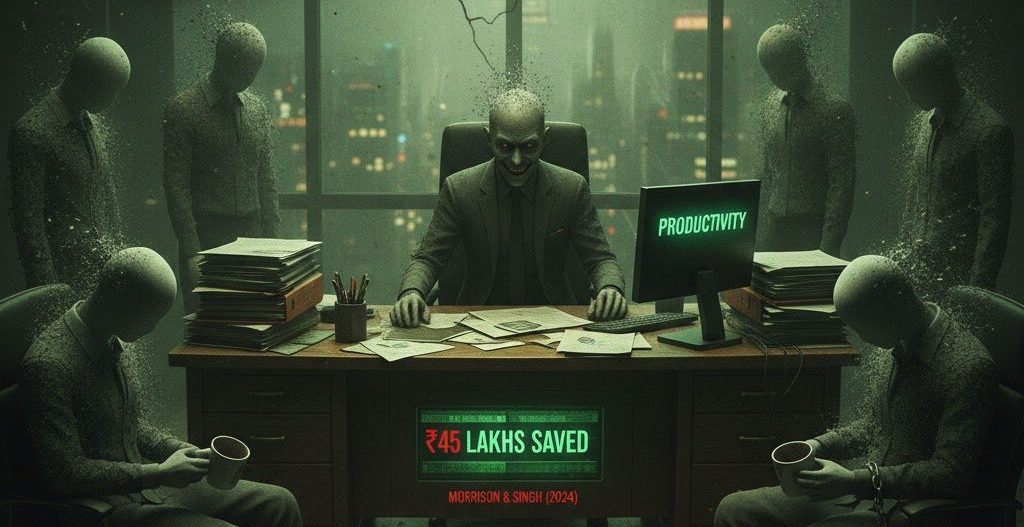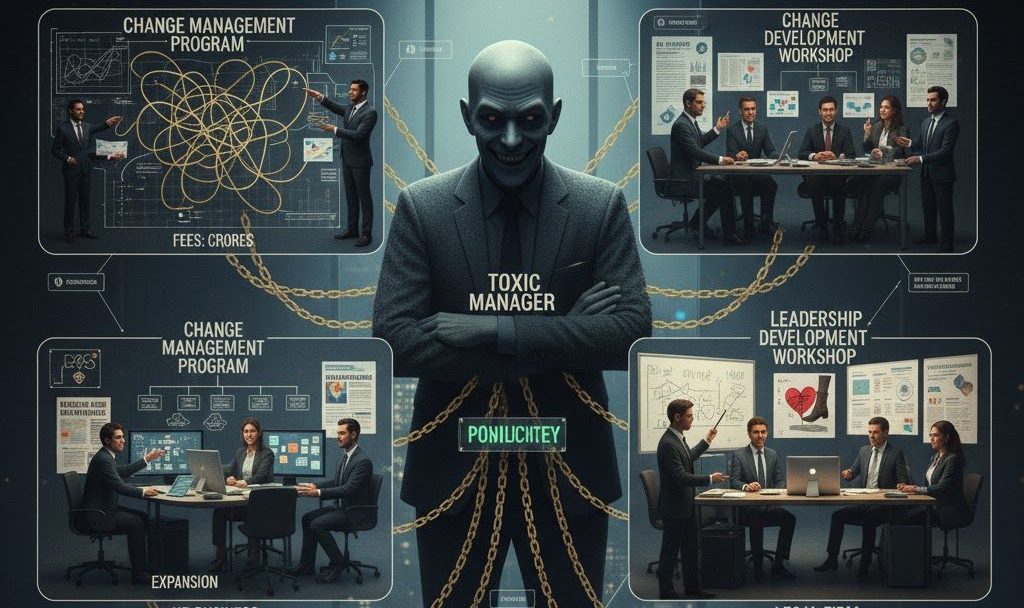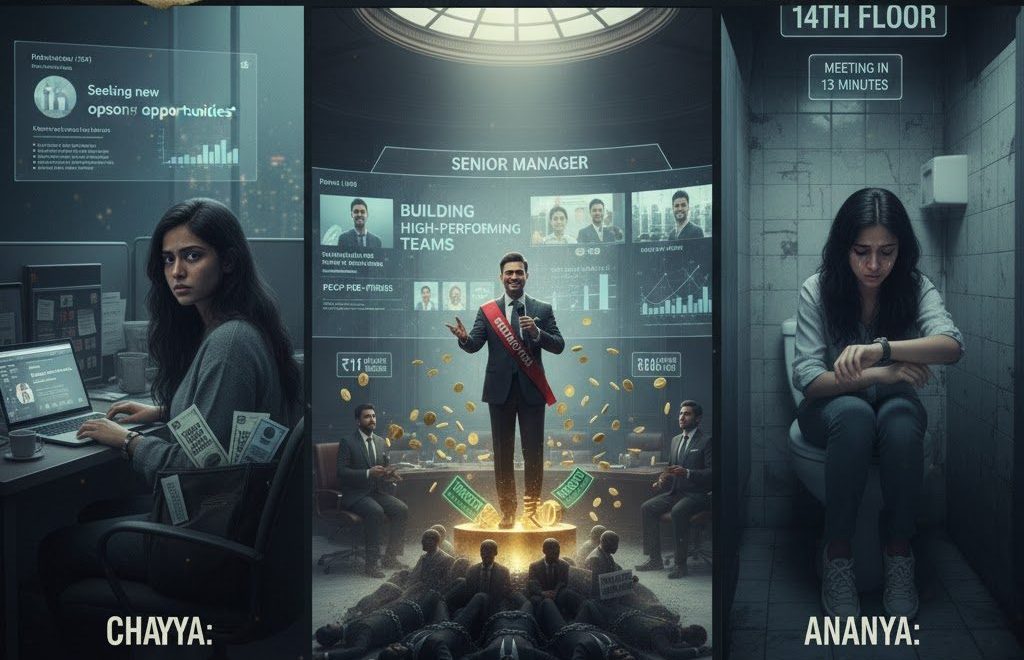12:47 pm. Chhaya checks her phone in the bathroom. 13 minutes until the team meeting. 13 minutes to stop shaking, fix her makeup, and pretend Rajesh’s morning email—the one CC’ing senior leadership about her “concerning lack of urgency”—didn’t make her physically sick.
She doesn’t know she’s one of a statistic. 67% percent of Indian employees have worked under a toxic manager. But here’s the part that would make her stomach drop: only 8% of these managers ever get fired for their behavior (IIM Bangalore, 2023).
The other 92%? They’re thriving.
Last year, Harvard Business Review (HBR) published research that reads like a corporate horror story. Toxic managers save companies an average of ₹45 lakhs annually—not through brilliance, but through a calculated erosion of human dignity (Morrison & Singh, 2024).

The math is simple. Demoralized employees don’t negotiate salaries aggressively. High turnover means no long-term training investments. Fear-driven teams deliver short-term productivity spikes that look spectacular in quarterly reports.
An IIM Bangalore study found companies with toxic middle management showed 23% higher short-term productivity compared to supportive leadership cultures (Krishnan et al., 2023).
Replacing a toxic manager costs roughly ₹12-15 lakhs. But the cost of their toxicity? That’s externalized to the employees below them. It appears nowhere on balance sheets—except maybe in increased health insurance claims.
“We track everything else obsessively,” says Meera Shenoy, who spent 15 years in HR leadership before founding a workplace advocacy group. “Revenue per employee, utilization rates, productivity metrics. But the cost of broken people? That’s invisible to finance teams.”
The Promotion Paradox
A comprehensive analysis of India’s top 100 companies by market capitalization revealed what insiders have always suspected: managers with the highest employee complaint ratios had a 43% higher chance of promotion (Sharma & Reddy, 2024).

Read that again. The worse they treat you, the faster they climb.
A confidential survey of 500 C-suite executives across India revealed why. 78% percent admitted knowing about toxic managers in their organizations. 84% percent said these managers hit aggressive targets more consistently. 92% percent believed removing all toxic managers would hurt short-term profitability (Anonymous consulting firm, 2024).
They know. They’ve always known.
“Toxic managers are heat shields,” explains Dr. Anita Kapoor, an organizational psychologist who’s studied corporate dysfunction for two decades. “They implement unpopular decisions that executives can later distance themselves from. They absorb employee anger. They’re the bad cops in an elaborate good cop-bad cop routine.”

Dr. Robert Hare’s research on corporate psychopathy adds another disturbing layer: 1 in 25 business leaders exhibits psychopathic traits, compared to 1 in 100 in the general population (Hare, 1999). But the question nobody wants to ask is whether psychopaths rise to leadership or whether leadership creates psychopaths.
The Machine Learns to Be Mean
When AI entered the workplace, we thought it might herald kinder management. Automation would handle grunt work, freeing humans for creativity and collaboration. Instead, something more sinister happened.
MIT researchers studying AI implementation in Indian workplaces found toxic managers were 65% more likely to successfully adopt AI tools—and once they did, they became 40% more effective at monitoring, controlling, and pressuring their teams (Zhang et al., 2024).
Now Rajesh doesn’t just micromanage. He has real-time productivity dashboards. He doesn’t criticize arbitrarily. He has algorithmic “data” backing every attack. “The system flagged your performance,” he says, as if the algorithm wrote itself.
Facial recognition software analyzes stress levels during meetings—not to offer support, but to identify who’s “not committed enough.” Your anxiety becomes a performance metric. Your body’s distress signals build a case against you.
“AI hasn’t made workplaces kinder,” says tech ethicist Rohan Desai. “It’s made cruelty more efficient and given it a veneer of objectivity.”
The Ecosystem of Suffering
Follow the money, and you’ll understand why nothing changes.
Consulting firms earn crores running “change management” programs that never actually change toxic managers. HR departments expand their empires managing the fallout—every toxic manager requires additional business partners, wellness programs, and conflict resolution specialists. Training companies thrive on “leadership development” workshops where managers learn to say “I hear you” before crushing souls. Legal firms bill by the hour handling harassment cases and “mutual separation” agreements.

Everyone profits from the problem except the employees suffering under it.
“It’s a perfect economic system,” observes workplace researcher Vikram Malhotra. “The disease justifies the cure, but nobody actually wants to eliminate the disease because too many people are paid to treat the symptoms.”
The Conversion
A longitudinal study of 1,000 Indian professionals over 5 years reveals the most heartbreaking pattern (Patel et al., 2024).
Year 1: 89% believed toxic managers should be fired.
Year 3: 67% had “learned to work around” toxic management.
Year 5: 34% had become toxic managers themselves.
The system doesn’t just survive resistance. It converts resisters into perpetrators. “I went through it, so can you,” becomes the mantra. Trauma becomes tradition.

We thought Gen Z would refuse to tolerate this. We thought their mental health awareness would translate into zero tolerance for abuse.
But Gen Z employees, facing brutal job markets and unprecedented debt, are showing 23% higher tolerance for toxic behavior compared to millennials at the same career stage (Kumar & Associates, 2024).
Economic desperation breeds acceptance. When you have ₹15 lakhs in education debt and 200 candidates competing for every job, you learn to smile through abuse. You learn to say “thank you for the feedback” when humiliated in front of clients.
The Justifications
Senior executives have developed elaborate philosophies to justify the unjustifiable.
“Market realities demand tough managers.” (Translation: Our competitors abuse their employees, so we must too.)
“Difficult managers build character and resilience.” (Translation: The trauma we inflict is actually a gift.)
“Only the strong survive—it’s Darwinian selection.” (Translation: If you can’t handle systematic psychological abuse, you deserve to fail.)
“We’re honoring Indian work culture’s hierarchical traditions.” (Translation: We’re invoking thousands of years of history to justify conference room screaming.)
These aren’t just excuses. They’re corporate mantras repeated until everyone believes them.
The Ending We Keep Living
Chhaya will eventually leave. She’ll cite “seeking new opportunities” on LinkedIn. She won’t mention the anxiety medication, the therapy bills, the three months it took to stop waking up at 3 AM with work dread.
Rajesh will get promoted to Senior Manager. He’ll speak at leadership conferences about “building high-performing teams.” He’ll be featured in company videos about “our people-first culture.”
The bathroom stall will welcome a new occupant. Maybe Ananya, fresh out of college, who still believes working hard will be enough.




 Dr. Jaimine Vaishnav is a faculty of geopolitics and world economy and other liberal arts subjects, a researcher with publications in SCI and ABDC journals, and an author of 6 books specializing in informal economies, mass media, and street entrepreneurship. With over a decade of experience as an academic and options trader, he is keen on bridging the grassroots business practices with global economic thought. His work emphasizes resilience, innovation, and human action in everyday human life. He can be contacted on jaiminism@hotmail.co.in for further communication.
Dr. Jaimine Vaishnav is a faculty of geopolitics and world economy and other liberal arts subjects, a researcher with publications in SCI and ABDC journals, and an author of 6 books specializing in informal economies, mass media, and street entrepreneurship. With over a decade of experience as an academic and options trader, he is keen on bridging the grassroots business practices with global economic thought. His work emphasizes resilience, innovation, and human action in everyday human life. He can be contacted on jaiminism@hotmail.co.in for further communication.